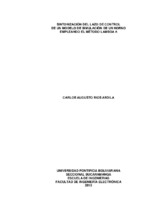| dc.contributor.advisor | Ángel Silva, Luis | |
| dc.contributor.author | Ríos Ardila, Carlos Augusto | |
| dc.coverage.temporal | 2013 | |
| dc.date.accessioned | 2020-09-14T23:00:58Z | |
| dc.date.available | 2020-09-14T23:00:58Z | |
| dc.date.issued | 2013 | |
| dc.identifier.uri | http://hdl.handle.net/20.500.11912/6016 | |
| dc.description | 70 páginas | spa |
| dc.description.abstract | En la presente monografía se aborda la técnica de sintonización Lambda, la cual es aplicada para realizar el control de temperatura en un horno eléctrico doméstico, donde el parámetro de diseño lambda, permite modificar la velocidad de respuesta del horno, sin la presencia de un sobre impulso.
Una prueba de identificación en lazo abierto es llevada a cabo, para caracterizar los parámetros de un modelo de primer orden mas tiempo muerto, los cuales son empleados para obtener las constantes de controlador PID.
Comparaciones son realizadas entre los métodos Lambda, Ziegler-Nichols y Cohen Coon, a fin de establecer las fortalezas y debilidades. También es comparado la forma como el controlador reacciona, ante la presencia de perturbaciones.
Finalmente, observaciones y conclusiones son presentadas para el método lambda y las ventajas de su implementación frente a otros métodos de sintonización. | spa |
| dc.description.abstract | In this paper deals with the Lambda tuning technique, which is applied to perform control of the temperature in a domestic electric oven, where lambda design parameter, allows modifying the response speed of the oven without the presence overshoot.
Open-loop test identification is performed, to characterize the parameters of a first order plus dead time model, which are used to get PID controller constants.
Comparisons are made between Lambda, Ziegler-Nichols and Cohen Coon methods, in order to establish the strengths and weaknesses. It is also compared the way in which the controller reacts, before the presence of perturbations.
Finally, comments and conclusions are presented for the Lambda method and the advantages of its implementation compared with other tuning methods. | eng |
| dc.format.mimetype | application/pdf | |
| dc.language.iso | spa | |
| dc.publisher | Universidad Pontificia Bolivariana | spa |
| dc.rights | Attribution-NonCommercial-NoDerivatives 4.0 International | * |
| dc.rights.uri | http://creativecommons.org/licenses/by-nc-nd/4.0/ | * |
| dc.subject | Hornos eléctricos | spa |
| dc.subject | Control de la temperatura | spa |
| dc.subject | Simulación | spa |
| dc.title | Sintonización del lazo de control de un modelo de simulación de un horno empleando el método LAMBDA | spa |
| dc.type | Especialización | spa |
| dc.publisher.department | Escuela de Ingenierías | spa |
| dc.publisher.program | Especialización en Control e Instrumentación Industrial | spa |
| dc.type.hasVersion | publishedVersion | spa |
| dc.description.sectional | Bucaramanga | spa |
| dc.description.degreename | Especialista en Control e Instrumentación Industrial | spa |


